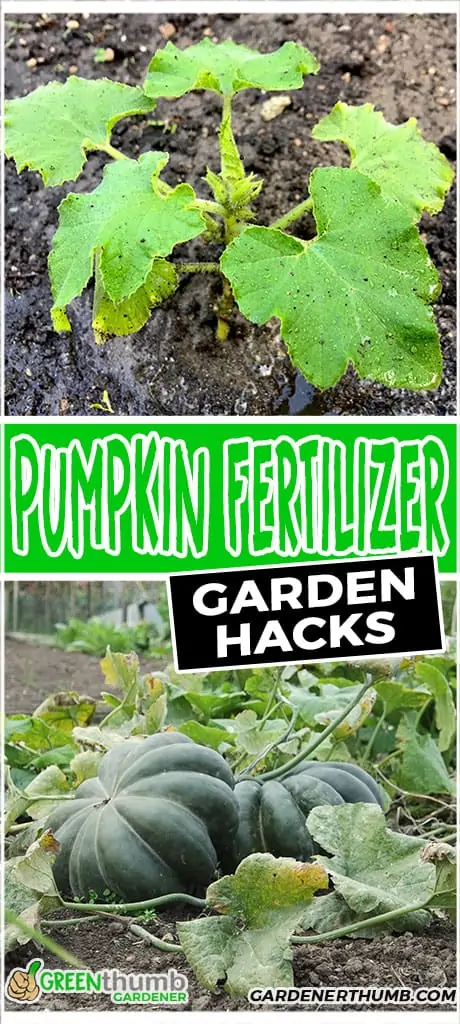Best Fertilizer For Pumpkins
Last updated: 6/20/2022
Ever wanted the biggest pumpkin patch in your neighborhood?
The Pumpkin is probably one of the most versatile types of the winter squash plant. We have grown to love the pumpkin and its hard, smooth ribbed skin with yellow to bright orange color, especially during Halloween and Thanksgiving.
A large percentage of giant pumpkin plants are harvested to become decorative ornaments during Halloween.
Farmers will bring out their giant pumpkins and families would join in the tradition of carving out pumpkins into jack-o’-lantern that are lit-up with candles inside.
Children will be at awe as they see the pumpkin fruit turn into a jack-o’-lantern with its flickering lights as they go around for their trick or treat.
During Thanksgiving, families share a delicious slice of pumpkin pie after a hearty dinner of roast turkey and other delicious dishes. Pumpkin fruit can also be baked, roasted, and made into a delicious purée.
It can also be mixed with salads or made into a warm and hearty soup.
Ok, so how do you make sure you grow some big pumpkins.
Well it starts with fertilizer.
Are you ready to learn some more tricks?
Green thumb Gardener occasionally links to product and/or services offered by vendors to assist you with all your gardening needs. Some of these may be affiliate links, meaning we earn a small commission if items are purchased.
Want to Download a Garden Hack Guide for FREE

Enter your email below and we will send you a guide to help you SAVE money in your garden.
Best Fertilizers For Pumpkins
| Image | Product | Features | Price |
|---|---|---|---|
Best Overall  | Espoma Organic Garden-tone 3-4-4 Organic Fertilizer |
| Check Current Price |
Best Liquid Option  | Urban Farm Fertilizers All Purpose Vegetable Fertilizer, 1 gallon |
| Check Current Price |
Best Balanced  | Jobe’s Organics All Purpose Granular Fertilizer |
| Check Current Price |
Understanding Fertilizers For Pumpkins
Growing pumpkin plant needs care, attention, and enough soil nutrients. Using fertilizers is very important since pumpkins are heavy feeders.
For different phases of its development, it will need various types of pumpkin fertilizers to support plant growth. The biggest pumpkins do not grow from the vines overnight.
Growing those prize pumpkins will take a balanced approach of all the right conditions.
They need the following for massive full growth:
- Rich Type of Soil
- Micronutrients
- Sunlight
- Right types of fertilizer

Types of Fertilizers
The sheer size of the pumpkin fruit will tell you that they are thirsty plants and need soil with plenty of nutrients to produce healthy fruit.
The natural nutrients in the soil may not be enough and sometimes you need to use commercial fertilizers to supply the needed plant food.
If you look at the three numbers in a commercial fertilizer’s packaging they represent the NPK or the Nitrogen, Phosphorus, and Potassium ratio.
It can be a balanced 10-10-10 NPK fertilizer ratio which means an equal amount of NPK or 5-10-5 which means a Phosphorus-heavy fertilizer for pumpkins.
They will need these nutrients in different ratios at various phases of plant development. It is recommended to conduct soil tests to accurately determine the levels of Nitrogen, Phosphorus, and Potassium.
This test will show the initial soil nutrient balance so you will know the pumpkin fertilizer requirements of your garden. Always remember to use commercial fertilizer in moderation use it in combination with compost or well-rotted manure before planting.
Even better is to give them some worm compost tea.
Manure that is not well-rotted may contain high concentrations of Nitrogen that may burn your plants.
Nitrogen
At the early stage of growth, the pumpkin needs fertilizer with a higher percent Nitrogen concentration to provide needed energy to develop the root, leaf, stem, and healthy vines.
Proper care should be taken when using nitrogen, you should avoid direct contact with leaves and vines because it may wilt or burn.
Phosphorus
As the plant develops into its flowering and fruit stage it would need a High-Phosphorus fertilizer ratio. It is an essential nutrient, fertilizing with phosphorus promotes the growth of roots, flowers, and fruit production.
Unlike Nitrogen, Phosphorous does not burn your plants and is also less water-soluble fertilizer.
Potassium
As the pumpkin continue to develop, their fruits will need Potassium-rich fertilizer. Fertilization with Potassium promotes the growth of fruits and helps them maintain a healthy plant.
Moderation is important and the right amount of Potassium should be used. Exact fertilizer should be given because too much potassium may overly speed-up the growth of the fruit.
It will make it outgrow its skin faster than necessary, causing the fruit to split or sometimes explode.
When To Fertilize Pumpkins
Like I have said in the previous section, the pumpkin needs different levels of nutrients depending on its stage of plant development.
A general-purpose balanced fertilizer with a 10-10-10 (NPK) fertilizer ratio may not be enough to maximize the development of the pumpkin roots, seeds, stem, flower, and fruit.
You can start by preparing a good, well-drained soil mixed with homemade fertilizer made from compost or well-rotted manure a few weeks before planting.
Use a nitrogen-heavy fertilizer at the start of the growing season to help it develop, but make sure you don’t apply it too close to the plant to prevent burning them.

When the flowers start to appear and form, use a more phosphorus-heavy fertilizer, it will aid in producing more blossoms and fruit.
Finally, when the pumpkins start to appear use a potassium-rich fertilizer to produce healthy fruit. Use this fertilizer in moderation because it might break the skin and explode from its sudden growth.
How to Fertilize Your Pumpkin Plants
Now that we know when to fertilize pumpkin plants let us now talk about how to fertilize them. So we usually want to fertilize the plant with more nitrogen-heavy fertilizer during pre-flowering, phosphorous-heavy fertilizer during flowering, and potassium-heavy fertilizer when the plant is fruiting.
Always follow the manufacturer’s instructions which are typically 1 1/2 pounds of fertilizer per 100 square feet (ca. 9 square meters). When using granular fertilizers, make sure it is scattered evenly on the ground around the plant and not on the plant itself.
But is also okay to use water-soluble or liquid fertilizers. Some fertilizers like nitrogen may burn your plant when it gets into direct contact with the leaves or vines.
Do not forget to water your plants.
You can start with granular fertilizers and the shift to liquid fertilizers although it is a little more expensive.
How to Grow Giant Pumpkins
In order to grow giant pumpkins, they need a lot of sunlight, nutrient-rich soil, sufficient plant food, and fully prepared soil.
Not all pumpkins are the same, if you want to grow large pumpkins you have to choose the right seed variety.
The “Prizewinner”, “Atlantic Variety” and other “giant’ varieties should be used.
Simply put around two to three seeds per cell and cover them with thin soil on top. Once your seedling grows remove all the weak seedlings and retain the strong ones.
Cover the seedlings with a cloche, which is a glass covering or a cold frame to protect them from frost or wind. Pumpkins need a lot of sunlight and once the fruits appear choose the best shape ones and removed others, this will encourage the growth of the good fruits.
Make sure there is enough room for the pumpkin to grow, remove other fruits if they are growing too close to one another.
Do not forget to place fertilizers following the suggested time as discussed in the previous section. The pumpkins will be ready for harvesting in 95 to 110 days.
Final Thoughts
Growing the best pumpkins will require time, effort, and care but with the right steps and attitude, we surely are reward with a great harvest of large and healthy pumpkins.
You can enjoy them all year round both as a beautiful decorative ornament and delicious dish.
Related Questions
Is Miracle Grow good for pumpkins?
Miracle grow can help the pumpkins grow but it has to support regular watering, trimming, and sunlight. It is also best to use it with other products that have specific NPK ratios especially during flowering and fruiting stages.
When should I fertilize my pumpkins?
You may already have some rich soil to help promote the green growth of vines. You will get bigger & better results if you do add some fertilizers. We always suggest using soil test kits prior to planting to know your current soil nutrients.









